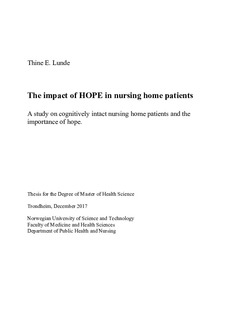| dc.description.abstract | Introduction: Over the next decades the generation of older adults is expected to increase significantly worldwide. As elderly are often suffering from multimorbid an increasing number will be in need of nursing home care. Hope is found to be needed by all persons throughout the life cycle including the end of life, and is viewed as a resource to provide strength when experiencing illness and losses. In this thesis hope is defined as a multidimensional dynamic life force characterized by a confident, yet uncertain expectation of achieving a future that, to the hoping person, is realistically possible and personally significant. Therefore, the overall aim of this study is to explore and elaborate the concept of hope for cognitively intact nursing home patients in Norway in relationship to symptom burden and quality of life.
Method: In Paper 1 a qualitative method was used performed by a systematic literature search. With a phenomenological approach data was categorized and thereafter analyzed. In paper 2 a quantitative approach was applied. Here data was collected by a descriptive cross-sectional design, and analyzed by descriptive, correlation and regression statistics.
Results: Hope is found to be an essential coping resource among older adults, and to provide strength in times with suffering (Paper 1). Nursing home patients are found to be hopeful, at the same level as other patient’ groups. Findings indicate that physical and emotional symptoms have a significant relationship to hope, as well as to quality of life. Multiple regression analysis showed a positive relationship between hope and quality of life, and insomnia was found to have a slightly negative impact on hope (Paper 2).
Conclusion: Based on the findings hope is a multidimensional dynamic life force with an expectation of achieving good, and a vital resource for nursing home patients experiencing multimorbid and losses. Emotional symptoms seem to have a positive relationship to hope, and physical symptoms such as fatigue, nausea/vomiting, dyspnea and insomnia are shown to have a negative relationship to hope. Furthermore, increased insomnia is also found to have a direct negative impact on hope in nursing home patients, while quality of life has a positive effect on hope. | nb_NO |
